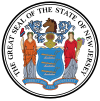New York Bay
This article needs additional citations for verification. (December 2020) |

New York Bay is the large body of water surrounding the mouth of the Hudson River where it empties into the Atlantic Ocean. It is shared by the states of New York and New Jersey in the United States. A New York Harbor Storm-Surge Barrier has been proposed to protect it from flooding.
Geography[]
New York Bay is usually divided into two major components, which are connected by the Narrows. They are Upper New York Bay and Lower New York Bay.
The term New York Harbor usually refers to Upper New York Bay and the surrounding Port of New York and New Jersey, but sometimes is taken to be a synonym for New York Bay.
Upper New York Bay includes several islands. Liberty Island is the location of the Statue of Liberty. Nearby Ellis Island is known as a former immigration station. Governors Island is a former military base, now a park and historic site. Robbins Reef Light is also in the upper bay. Lower New York Bay includes Hoffman Island and nearby Swinburne Island. Both are artificial islands that are closed to the public.
History[]
Commissioned by King Francis I of France, the Florentine explorer Giovanni da Verrazzano is the first European to discover the Bay in 1524. He gave it the name of « New Angoulême » in honor of the King who was also Count of Angoulême[1]
See also[]
- Geography of New York Harbor
- Geography and environment of New York City
- Port of New York and New Jersey topics
References[]
- ^ "It is indeed in 1524 that the French expedition led by the Florentine Giovanni Da Verrazzano discovered the New York bay for the first time". The New York Foundation. Retrieved 7 March 2021.
Coordinates: 40°38′N 74°03′W / 40.64°N 74.05°W
- Bays of New Jersey
- Bays of New York (state)
- Bays of the Atlantic Ocean
- Bodies of water of New York City
- Bodies of water of Hudson County, New Jersey
- Bodies of water of Monmouth County, New Jersey
- Borders of New Jersey
- Borders of New York (state)
- East Coast of the United States
- Geography of New York City
- Hudson River
- Port of New York and New Jersey
- New York City geography stubs


